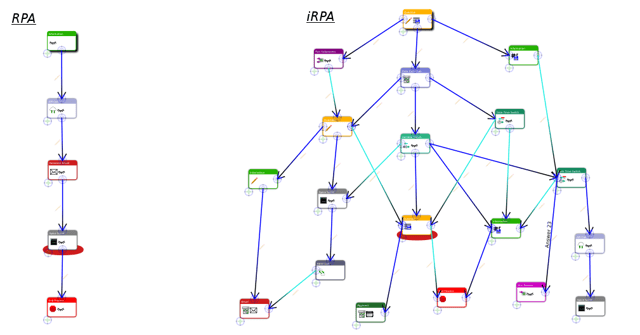
When looking for a process automation solution it is easy to get caught up in the hype around Robotic Process Automation (RPA). But when you really examine the options available it is clear that standard RPA solutions don't even come close to competing with Intelligent Robotic Process Automation (iRPA).
Some companies claim that they have an RPA solution but when you dig into their definition of RPA it is just a script that can be created by one of their programmers. Other companies have impressive workflow tools that setup an RPA process but can only be executed in a linear fashion; there is little to no logical decision making. These systems have to wait for human interaction to fix any issue that cannot be handled by the linear process. Many of the RPA solutions have to be trained like a human would be trained, learning where to click and when. This training process could take as long as it would to train an actual person. The process of training an RPA solution seems cumbersome especially when you consider that it can only handle linear processes.
SpiceCSM takes a different approach to process automation: adding multiple layers of intelligence. The SpiceCSM Guided Process Builder allows for the creation of Automated Processes. These processes can extract information from anywhere on the web and temporarily save it for use within the process. Multiple data sources can be imported, manipulated and then pushed out to anywhere on the web. Imported information can be used to route the process down different paths, thus mimicking human decision making. The processes can also be routed based on date and time; adding yet another layer of intelligence. The ability to import data, route the process based on that data and then re-route the process based on the date and time adds a tremendous amount of intelligence to the workflows.
The SpiceCSM platform has the ability to automate process workflows in a variety of ways. Independent processes can be set to run in the background while users are clicking through the Unified Agent Interface. Processes can be set to run on a timer, for example every day at 2:00 AM. Processes can also be triggered from anywhere on the web via a POST request.
Process automation solutions need to be adaptable to the changing needs of any company. The future of process automation is iRPA. It is important that companies select an iRPA solutions that is flexible enough for its current and future needs.
Want to learn more? See our previous blog, Simplifying Robotic Process Automation, to learn more about the guiding principles you should consider when researching and implementing a process automation solution. Or, just Contact Us. At SpiceCSM we're passionate about digital transformation and would love to discuss your needs and goals.


